Cinema has always captivated people’s eyes since the creation of silent films and modern masterpieces, and in the early to mid-twentieth century, foreign films started to gain popularity in America. Japan, in particular, had just been released from American control following World War II; during this occupation of Japan, any film ideas involving anything to do with traditional Japanese culture were prohibited from being shown on the silver screen. It was against this post-war backdrop that Japan would find ground in American film culture. In 1954, Japanese film director Akira Kurosawa brought what many critics would call the most excellent foreign film to be put on the silver screen, The Seven Samurai. This film would place Japanese cinema on the global map, inspire many young directors to pursue their passion for filmmaking, and look to Japan for film inspiration.
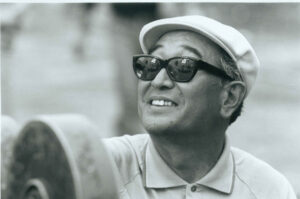
Before making Seven Samurai, Akira Kurosawa was already a well-established director with films such as Rashomon and Ikuru. While Kurosawa made movies set during Japan’s feudal era, like Rashomon, which had seen some popularity in Europe, this would be his first attempt at a samurai movie.1 Originally, when Kurosawa pitched the idea to Toho Studios, the film only consisted of six samurai; this initial pitch of Seven Samurai was not his original draft of the film as it was initially only meant to tell the story of a single samurai, but this was changed to six by Kurosawa and then to seven as it sounded better and was a more cohesive number. This raised the challenge of casting the seventh Samurai for this epic tale.2
Kurosawa turned to an actor with whom he had worked in the past, Toshiro Mifune. At this time, Mifune had already gained fame in some of Kurosawa’s previous films, and his addition to this cast almost seemed natural, as if he were meant to be in it all along. Mifune would join this movie’s star-studded cast, with actors like Takashi Shimura and Isao Kimura signing onto the project. Takashi Shimura, who was cast to play the leader of this rag-tag band of samurai, is one of the things that makes this film great as his stoic performance adds a weight and nuance to the film that would be missing without him there. Equally as important is the character of Kikuchiyo, portrayed by Toshiro Mifune, whose journey from brash outsider to selfless heroism provides a poignant counterpoint to Shimada’s quiet, stoic, and wise leadership of the group.3 The reason for the stark differences in the characters is that Kurosawa decided that if all the samurai were like Shimada, then the film would be boring and dull.

However, even though the studio was okay with Kurosawa making the film, they were unsure if he could grasp a film this size. It was his first samurai movie, and the battles and concepts he presented when pitching his film to the studio were significant and required several actors and extras to make the scenes feel real and have the weight he was looking for. After all, Kurosawa planned for this movie to be epic, with well-thought-out characters and fight scenes that could last up to 30 minutes at some points in the film.
This was the first challenge that Akira Kurosawa would have to tackle to prove to the studio that he could handle the momentous task he had placed upon himself. However, Kurosawa was determined to get this project up and running now that he had found his seventh Samurai in Toshiro Mifune. Kurosawa had always shown extreme attention to detail, even in earlier works like Rashomon and Ikuru, and his attention to detail in this film would be no different. When the production of Seven Samurai began, one issue remained prominent throughout the shoot: the budget. Toho, the studio behind Seven Samurai, was also working on another film that would require an incredible amount of money to produce and one that people would say had an even more lasting impact on pop culture, Godzilla. 4 These two productions ran side by side and even shared actors between the two films. Takashi Shimura, for example, was one of these actors who appeared in both movies and had leading roles in both films.
As the movie’s production continued, it faced many other issues, such as Kurosawa’s attention to detail starting to get the better of him. The production began to fall behind schedule. At first, it was only a few days behind, then it turned into weeks, and then slowly and slowly, it turned into months and months behind. The reason that this happened was that Kurosawa was not a fan of studio sets and preferred to film on location, which means in the actual place it was meant to be shot; in the case of Seven Samurai, Kurosawa would film the entire film in the Tagata district in the Izu Peninsula of Japan near the famous Atamti hot springs. The studio began to pressure Kurosawa to begin making shortcuts in his film, such as making sets that could be quickly taken down and moved to a studio. However, Kurosawa stuck to his guns and told the studio that they would have to be patient and do what he wanted to do for the film to meet the expectations he had set for them. As one could have determined, the studio was unhappy with this response and delayed the film’s production. 5
However, Kurosawa was not discouraged by this at all. He believed the studio had put far too much time and money into the film’s production to keep it off the silver screen. The actors also had enough hope that the film would pick this up, so they treated this as a bit of vacation from shooting. 6 Eventually, Kurosawas’ persistence paid off, and the studio called him back to restart the film’s production. This would not be the only time that Studio Toho would shut down production, but they would always call Kurosawa back to pick up the reins of this mighty film.
The production was so far behind that the final climatic battle scene, which was initially supposed to be shot in Japan’s warm summer months, was pushed back to the dead of winter and shot in freezing temperatures. Then, the production faced one last and final hardship during the production of this film, the weather, this is something that neither the studio or Kurosawa himself planned for. The day came to shot the climatic final battle of the film and when they walked out to shoot the scene they saw something they all did not want to see, storm clouds looming in the distance and approaching at a steady pace. However, Kurosawa would shake this off and begin shooting this climatic scene. Right before their first take, the rain came pouring and crashing down onto the actors and the crew, but Kurosawa used this to his advantage and made the most of the situation, they filmed the final battle with dozens of actors and extras soaked and freezing the rain running around waving swords and yelling there lines and at the end of the day Kurosawa could not have been happier with the result of the final battle and so were the actors even though some said they had never felt so cold while filming a scene before. 7
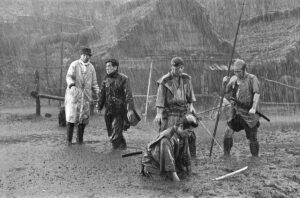
The film was now complete after nearly a year-long production and being way over budget. Being finally complete, it had a final run time of 207 minutes including a four-minute-long intermission in the film. This was Studio Toho and Kurosawa’s longest film to date. The time came to release the movie in theaters. Would this be the success that Studio Toho and Kurosawa were looking forward for it to be? Within the first twelve months of its release, Seven Samurai grossed 268.23 million Yen, which is around 2 million dollars today, and it became Studio Toho’s highest-grossing film to date. While this may not seem like a lot by modern standards, this was huge for the time, as million-dollar movies were not very common and the idea of a movie making a billion dollars at the box office was something nobody thought was even possible. Kurosawa had done it. Not only was this movie a major financial success, but a critical one as well and was even well received with audiences.8
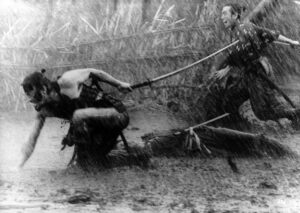
Outside of Japan, Seven Samurai also gained critical acclaim and for many served as the gateway movie for entering the world of foreign films. This film would go on to inspire many famous directors to make films. Examples of such directors are George Lucas, the creator of Star Wars, and even Steven Spielberg whose cinematic works need no remark. This film and many of Kurosawa’s later films would inspire American western films like The Magnificent Seven and A Fistful of Dollars, which some say are one-for-one copies of Kurosawa’s films. This film to this day is still the highest-rated Japanese film on IMDb and is the only film on the top 25 highest-rated films of all time to not have been made in the United States.9 The lasting impact that this film has made both abroad and domestically in Japan can not and should not be understated.
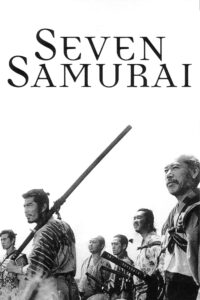
- Donald Richie, “The Films of Akira Kurosawa / by Donald Richie ; with Additional Material by Joan Mellen.,” January 1, 1998. ↵
- Toshiro Mifune interview (Pamphlet). Criterion Collection. August 25, 1993. ↵
- “Kurosawa: The Last Emperor (TV Movie 1999) – IMDb,” accessed April 28, 2024, https://www.imdb.com/title/tt0211909/. ↵
- Rayna Denison, “Franchising and Film in Japan: Transmedia Production and the Changing Roles of Film in Contemporary Japanese Media Cultures,” Cinema Journal 55, no. 2 (2016): 67–68. ↵
- “Kurosawa: The Last Emperor (TV Movie 1999) – IMDb,” accessed April 28, 2024, https://www.imdb.com/title/tt0211909/. ↵
- Donald Richie, “The Films of Akira Kurosawa” / by Donald Richie ; with Additional Material by Joan Mellen., January 1, 1999 . ↵
- Rob Nixon, “Behind the Camera of the Seven Samurai”. ↵
- Donald Richie, “The Films of Akira Kurosawa” / by Donald Richie ; with Additional Material by Joan Mellen., January 1, 1999. ↵
- “IMDb Top 250 Movies,” IMDb, accessed April 26, 2024, https://m.imdb.com/chart/top/. ↵
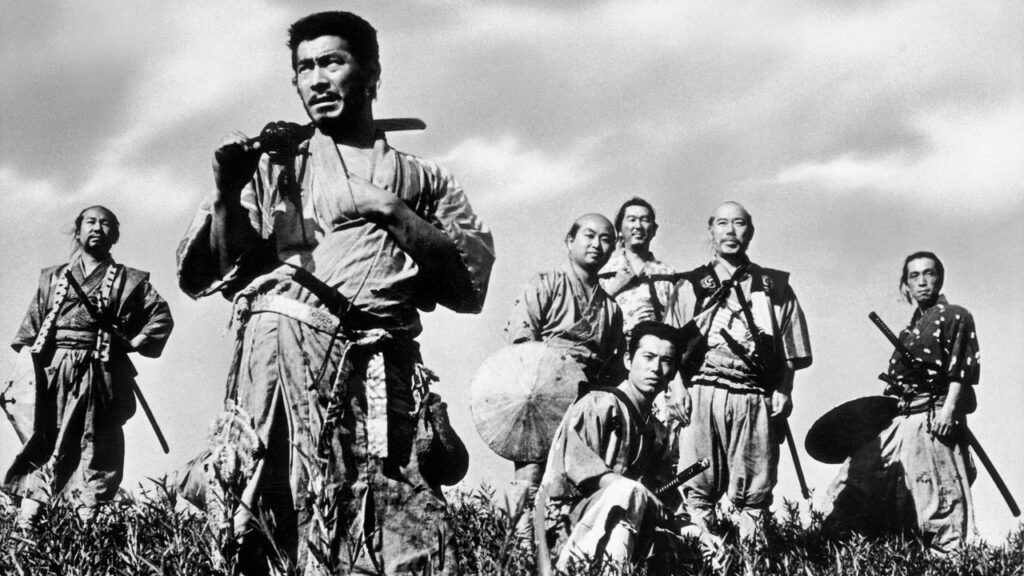
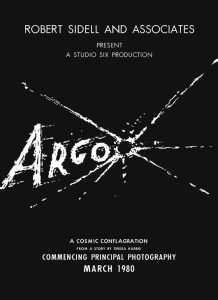
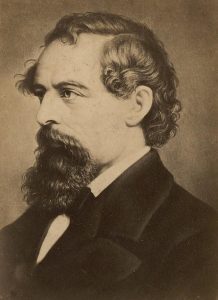
3 comments
Silvia Benavides
Wow, you have influenced me to watch this movie for sure! I identify with Kurosawa’s attention to detail and how that may have impacted the production of the movie and the predicted timeline was changed.
Gaitan Martinez
I have never heard of this movie, but now I want to check it out! It did annoy me how Kurosawa originally wanted six, but then was told to make it seven because I hate it when producers force a writer or director to change their work. However, I’m glad to hear he was able to smoothly work through the change.
Rhys Williams
I thoroughly enjoyed reading about Akira Kurosawa’s casting decisions in “Seven Samurai,” particularly his choice to bring back Toshiro Mifune, an actor with whom he had previously collaborated. The quote, “Takashi Shimura, who was cast to play the leader of this rag-tag band of samurai, is one of the things that makes this film great as his stoic performance adds a weight and nuance to the film that would be missing without him there,” beautifully encapsulates the significance of Shimura’s contribution to the film’s depth. It’s fascinating to learn how Kurosawa intentionally crafted a diverse cast of characters, recognizing the need for contrasting personalities to enrich the narrative and prevent monotony.